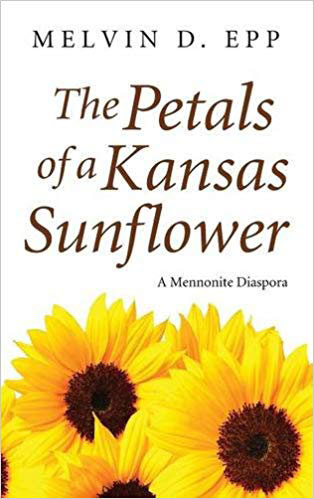Kansas Profile – Now That’s Rural: Melvin Epp, Remington Historical Society
August 22, 2018
 At right: Melvin D. Epp of Whitewater, Kansas wrote the book, 'The Petals of a Kansas Sunflower.' | Download this photo.
At right: Melvin D. Epp of Whitewater, Kansas wrote the book, 'The Petals of a Kansas Sunflower.' | Download this photo.
By Ron Wilson, director of the Huck Boyd National Institute for Rural Development at Kansas State University.
The bronze sculpture depicts a rider atop a rearing horse. It is a famous work of art created by Frederic Remington. One can find a copy of it in the Oval Office of the White House – as well as in the Kansas high school which bears Remington’s name. Today, the Frederic Remington Area Historical Society honors the legacy of this famous artist and others who lived in this rural region of south central Kansas.
Melvin D. Epp is a retired scientist, author, and president of the Frederic Remington Area Historical Society. This society’s goal is to preserve the local history in the area bounded by the Whitewater, Kansas school district, USD 206, which includes land once owned by artist Frederic Remington. Whitewater is a rural community of 718 people. Now, that’s rural.
Melvin grew up on a farm here. His family was active in the Mennonite church. Melvin attended Berean Academy (which his father helped found) and went on to earn a biology degree from Wheaton College, a master’s in botany from the University of Connecticut and a Ph.D. in genetics from Cornell University. Melvin Epp’s career as a botanical research scientist led him to St. Louis, the Philippines, and California.
In 1990 he moved back to Kansas. He ran the organic garden for the restaurant at the Riordan Clinic in Wichita and was named an honorary Master Gardener in Sedgwick County. He also got involved with the Frederic Remington Area Historical Society, for which he has served as president since 2007.
The high school in Whitewater is named for Frederic Remington because Remington once lived in this region. Remington had grown up in New York and shown an early aptitude for drawing. Horses were his favorite subject.
Remington traveled west and sketched a scene which became published in Harpers Weekly in 1882. It was Remington’s first commercially published work of art.
As of 1883, the wool trade was booming in the U.S. A friend of Remington’s convinced him to come to Kansas and try to make money in the sheep ranching business. Remington bought two quarter sections of land near Whitewater for his enterprise but chose to sell in 1884. He moved to Kansas City and eventually to New York for a career as painter, sculptor, and author. He was later termed one of our nation’s “great American painters.”
Remington’s first and most famous sculpture was the one he called “The Broncho Buster,” spelled with an extra “h” in broncho as was the spelling of the time. This sculpture has been called its century’s most popular small American bronze sculpture. After the Spanish-American War, Teddy Roosevelt’s Rough Riders presented him an original cast of this statue in appreciation. As mentioned, a copy stands in the Oval Office as well as at Whitewater’s Frederic Remington High School, in honor of its namesake.
Melvin Epp’s great-grandfather married a daughter of the man who sold Remington his farmland in 1883. A display of information about Remington stands in the high school today.
There is other rich history in the region as well, particularly about the Mennonite church. Melvin wrote a book, The Petals of a Kansas Sunflower, which describes the migration of Mennonites from West Prussia to Kansas in the 1870s, due to government regulations requiring them to join the Prussian army.
Melvin’s mother, Marie Harder Epp, was born in America to these relocated immigrants. “My mother was the village poet,” Melvin said. “People would ask her to write poems to honor someone.” Her first poem was written in 1929 and her last in 1991. The book includes 103 of her poems and describes the changes and challenges faced by these German-speaking Mennonite farmers. The book is available at booksellers such as www.amazon.com and others.
More information about the historical society can be found at its website.
Today, casts of the famous statue by Frederic Remington can be found from Washington, D.C. to rural Kansas. We commend Melvin Epp and all those involved with the Frederic Remington Area Historical Society for making a difference by preserving and sharing this history. Their commitment is like a beautiful work of art.
For print publications: Links in this story –
www.remingtonhistoricalsocietyks.org
Audio and text files of Kansas Profiles are available at http://www.kansasprofile.com. For more information about the Huck Boyd Institute, interested persons can visit http://www.huckboydinstitute.org.
----------------
The mission of the Huck Boyd National Institute for Rural Development is to enhance rural development by helping rural people help themselves. The Kansas Profile radio series and columns are produced with assistance from the K-State Research and Extension Department of Communications News Media Services unit. A photo of Ron Wilson is available at http://www.ksre.ksu.edu/news/sty/RonWilson.htm. Audio and text files of Kansas Profiles are available at http://www.kansasprofile.com. For more information about the Huck Boyd Institute, interested persons can visit http://www.huckboydinstitute.org.

